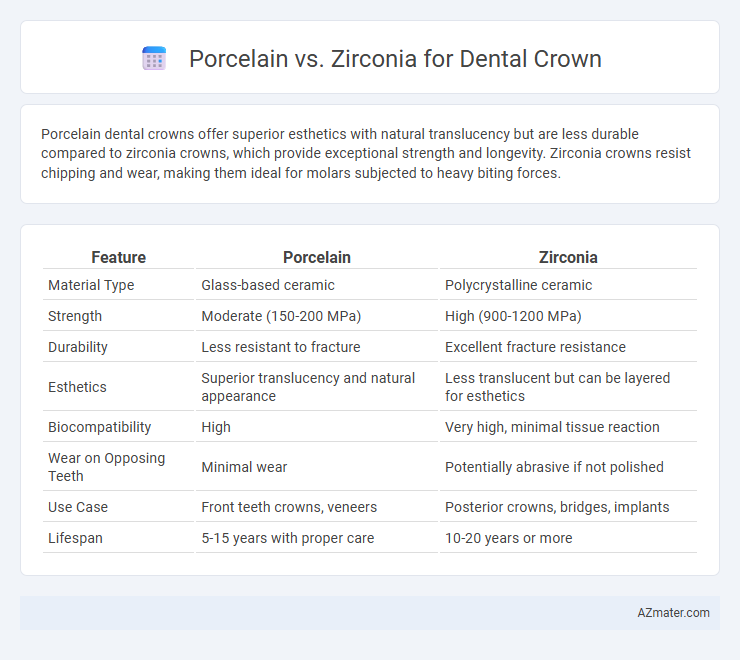Porcelain dental crowns offer superior esthetics with natural translucency but are less durable compared to zirconia crowns, which provide exceptional strength and longevity. Zirconia crowns resist chipping and wear, making them ideal for molars subjected to heavy biting forces.
Table of Comparison
| Feature | Porcelain | Zirconia |
|---|---|---|
| Material Type | Glass-based ceramic | Polycrystalline ceramic |
| Strength | Moderate (150-200 MPa) | High (900-1200 MPa) |
| Durability | Less resistant to fracture | Excellent fracture resistance |
| Esthetics | Superior translucency and natural appearance | Less translucent but can be layered for esthetics |
| Biocompatibility | High | Very high, minimal tissue reaction |
| Wear on Opposing Teeth | Minimal wear | Potentially abrasive if not polished |
| Use Case | Front teeth crowns, veneers | Posterior crowns, bridges, implants |
| Lifespan | 5-15 years with proper care | 10-20 years or more |
Introduction to Dental Crowns
Dental crowns restore damaged or decayed teeth by providing strength and improving appearance. Porcelain crowns offer superior aesthetics with translucency that mimics natural teeth, while zirconia crowns provide exceptional durability and biocompatibility. Both materials are popular choices depending on the balance between cosmetic needs and functional requirements.
What is Porcelain Crown?
Porcelain crowns are dental restorations crafted from ceramic materials designed to mimic the natural appearance of teeth with high translucency and color-matching capabilities. They provide excellent esthetics and are commonly used for front teeth due to their ability to blend seamlessly with surrounding dentition. Porcelain crowns offer biocompatibility, strong resistance to staining, and moderate durability, making them a popular choice for restoring teeth compromised by decay or damage.
What is Zirconia Crown?
Zirconia crowns are dental restorations made from zirconium dioxide, a durable, biocompatible ceramic material known for its exceptional strength and natural tooth-like appearance. Unlike porcelain crowns, zirconia crowns offer superior resistance to chipping and cracking, making them ideal for both anterior and posterior teeth under heavy biting forces. Their translucency and color can be customized to match surrounding teeth, providing an aesthetically pleasing and long-lasting solution for dental crown restorations.
Strength and Durability Comparison
Zirconia crowns offer superior strength and durability compared to porcelain crowns, making them ideal for patients requiring long-lasting dental restorations. Porcelain crowns, while highly aesthetic with a natural tooth-like appearance, are more prone to chipping and wear over time due to their lower fracture toughness. Studies show that zirconia crowns can withstand higher bite forces, often exceeding 900 MPa in flexural strength, whereas porcelain crowns typically range between 60-180 MPa.
Aesthetics and Color Matching
Porcelain dental crowns offer superior translucency and natural tooth-like appearance, making them ideal for front teeth where aesthetics are paramount. Zirconia crowns provide excellent strength while also allowing for effective color matching through advanced staining techniques, though they tend to be less translucent than porcelain. Both materials can be customized to match surrounding teeth, but porcelain remains the preferred choice for achieving the most lifelike color and appearance.
Biocompatibility and Patient Safety
Porcelain and zirconia dental crowns both offer high biocompatibility, but zirconia stands out for its superior resistance to bacterial adhesion and lower risk of allergic reactions, making it a safer option for patients with sensitivities. Zirconia's strong bioinert properties minimize inflammation and tissue irritation, enhancing patient safety during long-term use. Porcelain crowns, while aesthetically pleasing, may be more prone to chipping and wear, potentially leading to secondary issues affecting gum health.
Cost Differences Between Porcelain and Zirconia
Porcelain crowns typically cost between $800 and $3,000 per tooth, while zirconia crowns range from $1,000 to $2,500, reflecting variations in material durability and aesthetics. Porcelain offers superior translucency and better matches natural tooth color, often influencing higher prices in cosmetic cases. Zirconia provides greater strength and chip resistance, leading to longer lifespan and potentially lower long-term costs despite a higher upfront investment.
Clinical Performance and Longevity
Zirconia dental crowns exhibit superior strength and fracture resistance compared to porcelain, making them ideal for posterior restorations subjected to high occlusal forces. Porcelain crowns offer better esthetics due to their translucency, closely mimicking natural tooth enamel, but have higher susceptibility to chipping and wear over time. Clinical studies demonstrate that zirconia crowns maintain structural integrity and marginal adaptation longer, contributing to enhanced longevity and reduced need for replacement in high-stress areas.
Indications: When to Choose Porcelain or Zirconia
Porcelain dental crowns are ideal for front teeth due to their superior aesthetic qualities and natural translucency, making them perfect for visible smiles. Zirconia crowns are preferred for molars and areas requiring high strength and durability because of their exceptional fracture resistance and biocompatibility. Choosing between porcelain and zirconia depends on balancing aesthetic demands with functional needs, such as bite force and tooth location.
Conclusion: Which Dental Crown is Better?
Porcelain and zirconia crowns each offer distinct advantages depending on patient needs; porcelain crowns excel in aesthetic appeal with their natural translucency, making them ideal for front teeth restoration. Zirconia crowns provide superior strength and durability, suitable for molars where heavy chewing forces are common. Choosing the better dental crown depends on balancing aesthetic requirements with functional demands, with zirconia favored for longevity and porcelain preferred for its lifelike appearance.

Infographic: Porcelain vs Zirconia for Dental Crown
 azmater.com
azmater.com